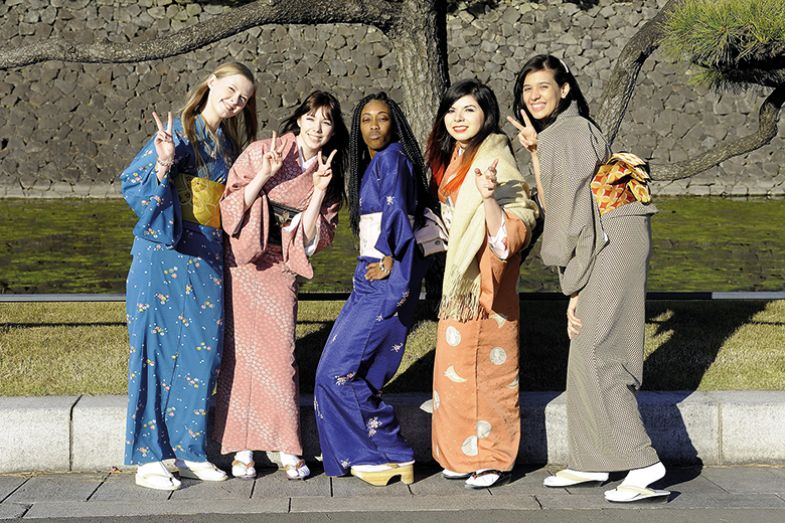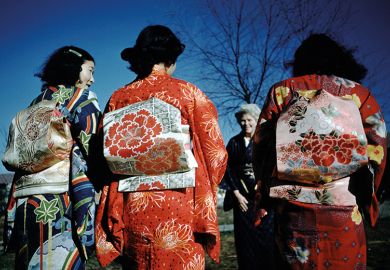It is a rain-soaked country centred on an island shaped like a backward L, just off the edge of the Eurasian continent. From the rugged north to the sandy south-west, its astonishingly resourceful, effusively polite people have long wielded global influence way out of proportion with their nation’s diminutive size. But the conditions that underlie that influence are more imperilled than at any point since the post-war era.
While that paragraph could easily be about the UK, it applies equally to the G7 island nation at the other end of Eurasia. Japan’s woes may not be as self-inflicted as those of Brexit Britain, but they are every bit as difficult – and the higher education sector is feeling the full brunt.
Demography presents the country with a challenge arguably bigger than any it has faced over the past two turbulent centuries. Japan has the world’s lowest birth rate, aside from one or two outliers like Monaco, and easily the greyest population, with about one-third of its inhabitants aged over 59.
The number of upper secondary school graduates in Japan has declined by 38 per cent since 1990, when the country’s previously booming economy began to flatline, and job vacancies outnumber applicants by more than 60 per cent. Such factors have prompted questions about the country’s ability to maintain a workforce capable of paying off the world’s largest public debt; Japan’s government owes around two-and-a-half times what its entire economy produces each year – a liability considerably worse than Greece’s, and unrivalled in peacetime economies.
The picture is not all gloom and doom, however. Japan’s economy is still the world’s third largest; in Bending Adversity, a 2014 book by former Financial Times Tokyo bureau chief David Pilling, a British MP visiting Tokyo early last decade is reported to have said: “If this is a recession, I want one.” And Japan’s universities continue to notch notable successes. In September, its top two institutions – the universities of Tokyo and Kyoto – both logged improvements in Times Higher Education’s World University Rankings, notwithstanding the concerted push by lavishly funded institutions in neighbouring China.
Kyoto improved its standing by nine places, reaching number 65 (Tokyo is 42nd). A few days later, the institution notched its 10th Nobel laureate – not counting peace prize winner Aung San Suu Kyi, who studied there briefly in the 1980s – when immunologist Tasuku Honjo was named co-winner of the prize in medicine. The award follows a series of Nobel prizes for Japanese researchers in recent years.
Annette Bradford, a British-born associate professor in the School of Business Administration at Meiji University in Tokyo, says such successes reflect the system’s resilience, and describes Japan’s demographic problems as “overplayed”. For example, she points out that despite the declines in school-leaver numbers, the most recent figures show that university graduate numbers are only marginally down on their 2009 peak, and 40 per cent higher than they were in 1990 (while graduations from junior colleges – a vocational alternative to university – have declined by 70 per cent over the same period). University participation now stands at about 50 per cent of 18-year-olds.
“I don’t think there’s necessarily a huge problem with the higher education system,” Bradford says. “It really is not dire.”
But, for others, it is precisely the scale of the Japanese sector that is the problem, given the funding available. Students are spread around 780 universities: about 80 per cent of them at the 600 or so private institutions. These do not have a government teaching subsidy, which means that their annual undergraduate fees are in the range of ¥1.25 million (£8,300) to ¥1.8 million, compared with ¥900,000 at public universities. But the 90-odd national universities have suffered a mandated 1 per cent annual cut in government funding since they were incorporated as autonomous institutions in 2004.
“Japan needs to take a harder, bolder look at these factors,” says Peter McCagg, a US-born academic administrator who has spent most of his 40-year career in Japan and is now vice president of academic affairs at Akita International University in northern Honshu. “The Japanese are not in the habit of spending a lot on education,” he says. “The idea that somebody could get a high-quality liberal arts education paying $7,000 [£5,300] a year tuition doesn’t really add up. There are a few good places to go to college in this country. But if your culture is that everybody has to do it, to some extent it inevitably waters down the quality of the overall pool.”
Nor are Japanese universities able to compensate for declining state funding by adopting the anglophone ploy of recruiting large numbers of high-fee-paying international students. This is because international students are included in tightly enforced admission caps – which also limit Japan’s ability to obtain skills through migration, as most other developed countries do.
In fact, foreign students in Japan generally pay no more in fees than their domestic peers, and often pay less. According to Christopher Pokarier, a professor of business and governance at Tokyo’s Waseda University, the practice of subsidising international students became entrenched in the 1980s, and when the public subsidies were removed around a decade ago, many universities opted to continue offering fee relief and partial scholarships at their own expense.
“The motivations were to promote apparent internationalisation, not least because of the perceived domestic branding advantages in doing so,” he says.
Other internationalisation efforts are premised on the idea that even small cohorts of foreign students can usher sweeping changes by fostering more competitive practices. The University of Tokyo’s first undergraduate programme taught in a language other than Japanese, launched in 2012, attracted about 30 students. But, according to Yujin Yaguchi, director of the university’s International Education Support Office, the initiative triggered changes across the campus. “Signage, curriculum – everything became bilingual,” he says. “It changed the university’s operation significantly.”
The changes were reinforced a year or two later, when the university expanded its exchanges with overseas universities. Now, about 200 Tokyo students head abroad each year and some 150 foreigners come the other way.
Some internationalisation programmes are working well, not only at big-name universities but also at smaller institutions like Akita, Tokyo’s International Christian University and Ritsumeikan Asia Pacific University in Kyushu.
But sceptics say these success stories are too small to have national impact. And they are the exception rather than the rule. Efforts to harness foreign staff and students as change agents often end up faltering because of indifference, institutional inertia or paltry English language skills within Japan, they say.
Another approach, exemplified in Kyoto’s new International Undergraduate Programme or “iUP”, involves importing foreign students – mainly from South-east Asia – and giving them two years of intensive Japanese training, followed by an undergraduate degree taught in the national language. Observers say this all but guarantees graduates employment with Japanese companies, since foreigners who speak the local language are highly prized in the labour market.
The problem is that such an education is less useful overseas, and it does little to change the famously insular culture of Japanese higher education. Futao Huang, a professor in the Research Institute for Higher Education at Hiroshima University and an expert on internationalisation, says there is little evidence that efforts to internationalise Japan’s student body are making a substantive difference, with much of the growth in international learners being among language students who do not progress to university. Nor have Western students arrived in the numbers needed to force change; Asian neighbours, led by China, remain the main source of overseas undergraduates.
But Meiji’s Bradford says many students can access international-style education if they want it. She says internationalisation is an overhyped “buzzword”, and that the desirability of degrees taught entirely in English is debatable. In the Netherlands, for example, universities have been accused of abandoning their own language.
Bradford says there is too much hand-wringing about Japanese results in the Test of English as a Foreign Language (TOEFL). “We always compare Japan to European countries and their great English,” she says. “We should be comparing ourselves more to the UK than to Europe, because we’re an island nation. In Germany, you can walk across the border into France. How many people in the UK can quickly switch into French?”

Ironically, when Japan’s imperial universities were created during the Meiji Restoration of the late 19th century – forged in the wake of Western gunboat diplomacy that forced the country to abandon centuries of feudal isolationism – all instruction was in European languages. The higher education systems of North America and Europe were imported wholesale, complete with syllabuses and teaching materials. Japanese academics and students were polyglots by default, until the teaching materials were translated into the local language some years later.
Japan’s internationalisation schemes are designed not only to recapture this multilingual flair. A parallel goal is to inject university administrations with the types of professional expertise that proliferates in Western systems.
Pokarier describes Japanese university administrators as “hard-working amateurs”. This results in institutions that, while not necessarily wasteful, are far from following best practice. Moreover, the refusal of many universities to hire permanent staff aged over 40 – or even 35 – means that there is “virtually no market for experienced university managers to move between institutions. Specialists in fields such as managing international programmes [are often] engaged on short-term contracts. Expertise is underdeveloped, underprofessionalised, immobile.”
Meanwhile, the so-called corporatised status of the national universities belies a level of bureaucratic meddling that no Western university would tolerate, including routine secondments of ministry staff to senior executive positions. Despite receiving little government funding, the 600-odd private universities also experience considerable ministry micromanagement, especially in the early stages of new programmes.
Consequently, university leaders have little practice in creative management, observers claim. Presidents are generally elected from among staff, so administrative flair is no pre-requisite to leadership. And senior executives tend to be moved around every three years, so if anybody comes up with a bright idea to improve the way things are done, it may not survive the next shuffling of the deckchairs.
Every few years, the government introduces a new competitive funding programme to nudge universities into fresh ways of doing things, from mobility and joint degree schemes to institutional money-spinners like commercial training arms. Tokyo’s Toyo University, for instance, is setting up a private enterprise funded under the 2014 Top Global Universities programme.
Shingo Ashizawa, a professor in international education who contributed to Toyo’s proposal, says that the new company offers diverse community outreach services, including English education for elementary school students. He says it will help diversify Toyo’s income sources even after the programme’s conclusion.
The Top Global Universities programme has been allocated a 10-year budget to pursue its ambition of planting 13 out of the 37 participating universities in the global top 100. Ashizawa says this is an improvement on the five-year duration of previous grant schemes and will allow Toyo to pilot new methodologies across two full student cohorts – enough to make “substantial differences” and to cement “institutional consent” towards international strategies. But he concedes that such schemes encourage reliance on the government for ideas, and lumber universities with new layers of compliance.
So much so that some university administrators breathe sighs of relief when they fail to win grants, because their hands are not so tied. While Akita International University was another of the 37 institutional winners under the Top Global Universities programme – bankrolling the recruitment of two extra academics, in a high school-sized institution with an annual budget of about ¥2.5 billion – it did not apply to a subsequent scheme. This was owing to the “burdensome” reporting requirements and the ministry’s habit of cutting promised funds while insisting that universities must still meet previously negotiated key performance indicators, according to McCagg, who cites the Japanese expression “poisoned manjū”: a reference to a popular confectionery.
“It looks so good; you take a bite and it’s poisoned,” he says. “That’s probably the word on the street about government grants…I can understand the thinking: you’re providing seed money, then little by little the institution needs to take over the fiscal responsibility. On the other hand, for a school like us, it’s really difficult to find additional funding for those activities.”
Trends in college and postgraduate degrees in Japan
Other rules and practices – many of them reflections of broader social mores – stifle innovation and foster complacency, critics allege. For instance, age rather than merit often governs appointments. In the education faculty of a western Honshu university, for example, there is an unspoken rule that nobody under 44 can be appointed professor. And all Japanese academics must retire at 65, regardless of how much they may have left to offer.
Before that watershed, of course, Japanese workers are famously obliged to work extremely hard. But the long hours are generally borne by men, as women bear the brunt of child-rearing and housekeeping duties – a Confucian division of labour which, ironically, faded in Confucius’ Chinese homeland during the cultural revolution. Gender imbalances are most evident at the top levels of higher education; all but a handful of the country’s university leaders are male, as are a reported 92 per cent of professors at The University of Tokyo. But inequities flourish at all ages, with women making up just 25 per cent of student enrolments at Kyoto.
Meanwhile, Japan’s career conveyor belt places great stock in the universities young people went to, but little in their academic results while there. This allegedly encourages students to take it easy until the last year or so of their degrees, when they vie for jobs at the nation’s big firms via choreographed career fairs. Some students fall asleep in auditoriums as greying professors recite lectures they have delivered, unchanged, a dozen times previously. Smarter students shirk lectures and divvy up assignments with classmates.
However, Waseda’s Pokarier insists that while passive learning is an issue in Japan and throughout East Asia, Western observers are “too quick to comfort themselves” that they do better. He says Japanese colleagues are astounded when he relates his experiences as an early career academic in Queensland, teaching introductory marketing to lecture halls filled with 1,500 students.
“The saving grace, we always told ourselves, was the tutorials,” Pokarier says. But those tutorials were taught “by honours students and anyone else we could find” – and some Western universities are now discarding tutorials entirely to cut costs.
Japanese universities tend to be small in comparison, with staff-to-student ratios far lower than those elsewhere. “All the staff know all the students by name,” Pokarier says. Academic advisers meet students regularly and there is “lots of reporting back to the parents. They really look after the students, and the parents demand that.”
In October, the World Bank awarded Japan third place in a new measure called the Human Capital Index , which quantifies the contribution of health and education to the productivity of the next generation of workers. And Pokarier points out that while they are lecture-based, Japanese university courses are supplemented with seminars – known in Japan as zemi, a shortening of the German Zeminar – in a model imported from Berlin’s Humboldt University during the Meiji Restoration. In their later years, undergraduates study in small groups, developing theses in close consultation with their academic advisers.
Japanese students also benefit from their departments’ ongoing contact with students from earlier student cohorts – which can result in tipoffs about job opportunities. “In Australia, you just don’t have that kind of connectivity,” Pokarier says.
As for comparisons with the UK, while academics in both countries may be surveying the future somewhat nervously, Bradford says that it is pointless to compare the Japanese system with that of her native country because the approaches are so utterly different. Japan’s comparative lack of independent learning, for example, reflects a vastly heavier class workload.
“When I was a student in the UK I had six classes a week,” she says. “These guys have 18 or so.”
Moreover, in contrast to the allegations that Japanese students can be prone to coasting, Bradford rates their capacity for hard work as far higher than that of UK students.
“You can’t say Japanese students don’t do homework,” she says. “If we gave them 150 pages of reading per class a week, they’d [refuse to do it].”
In Pokarier’s estimation, Japanese higher education researchers tend to be hyper-critical of their own system, and to have an “exaggerated sense” of standards elsewhere. But he thinks they – and the overseas observers who buy into these narratives – need to take a second look.
“In large part, our standards in Japan are quite high,” he says. “We just need a bit more self-confidence about projecting the brand.”
POSTSCRIPT:
Print headline: Hunkering down
Register to continue
Why register?
- Registration is free and only takes a moment
- Once registered, you can read 3 articles a month
- Sign up for our newsletter
Subscribe
Or subscribe for unlimited access to:
- Unlimited access to news, views, insights & reviews
- Digital editions
- Digital access to THE’s university and college rankings analysis
Already registered or a current subscriber?
















